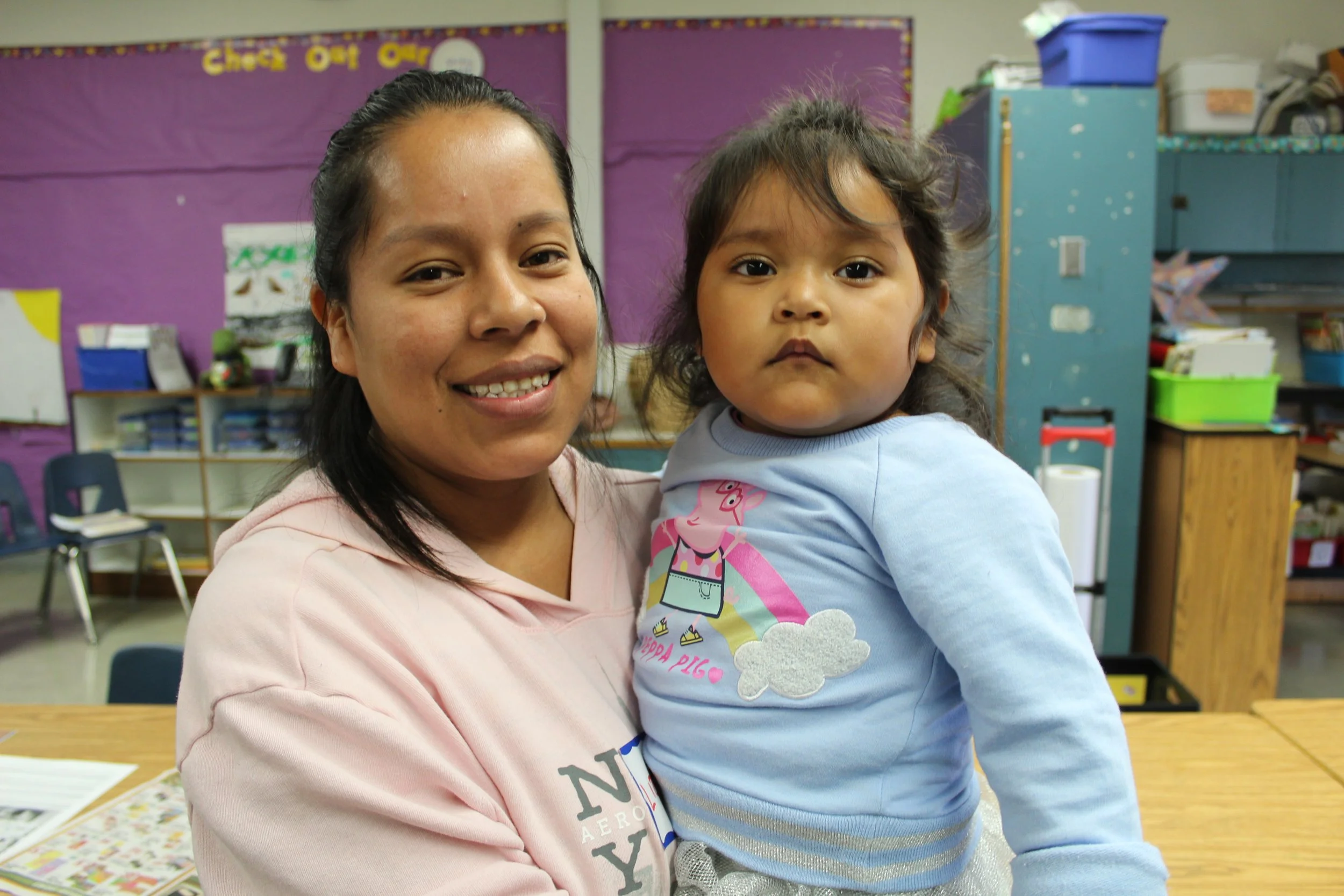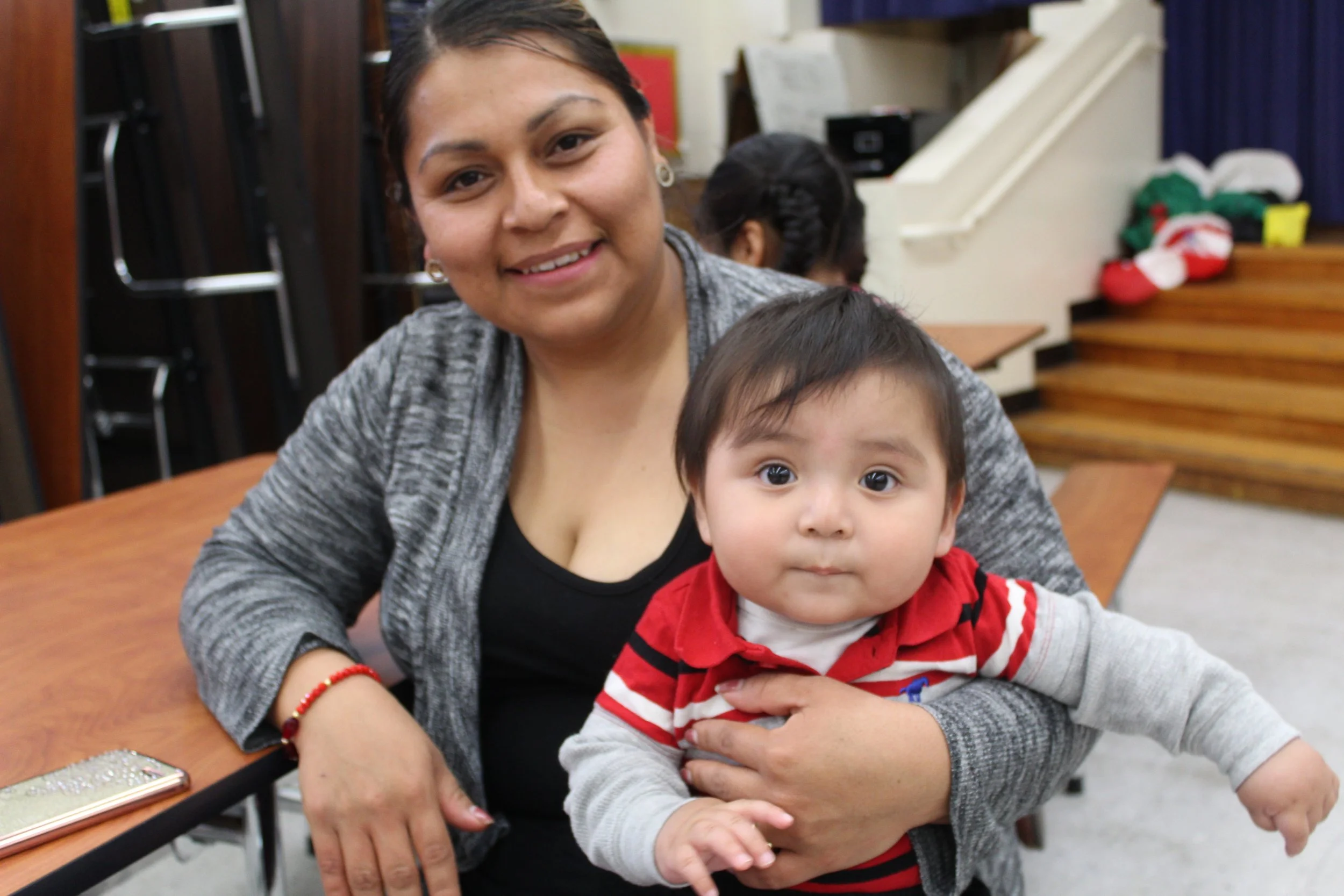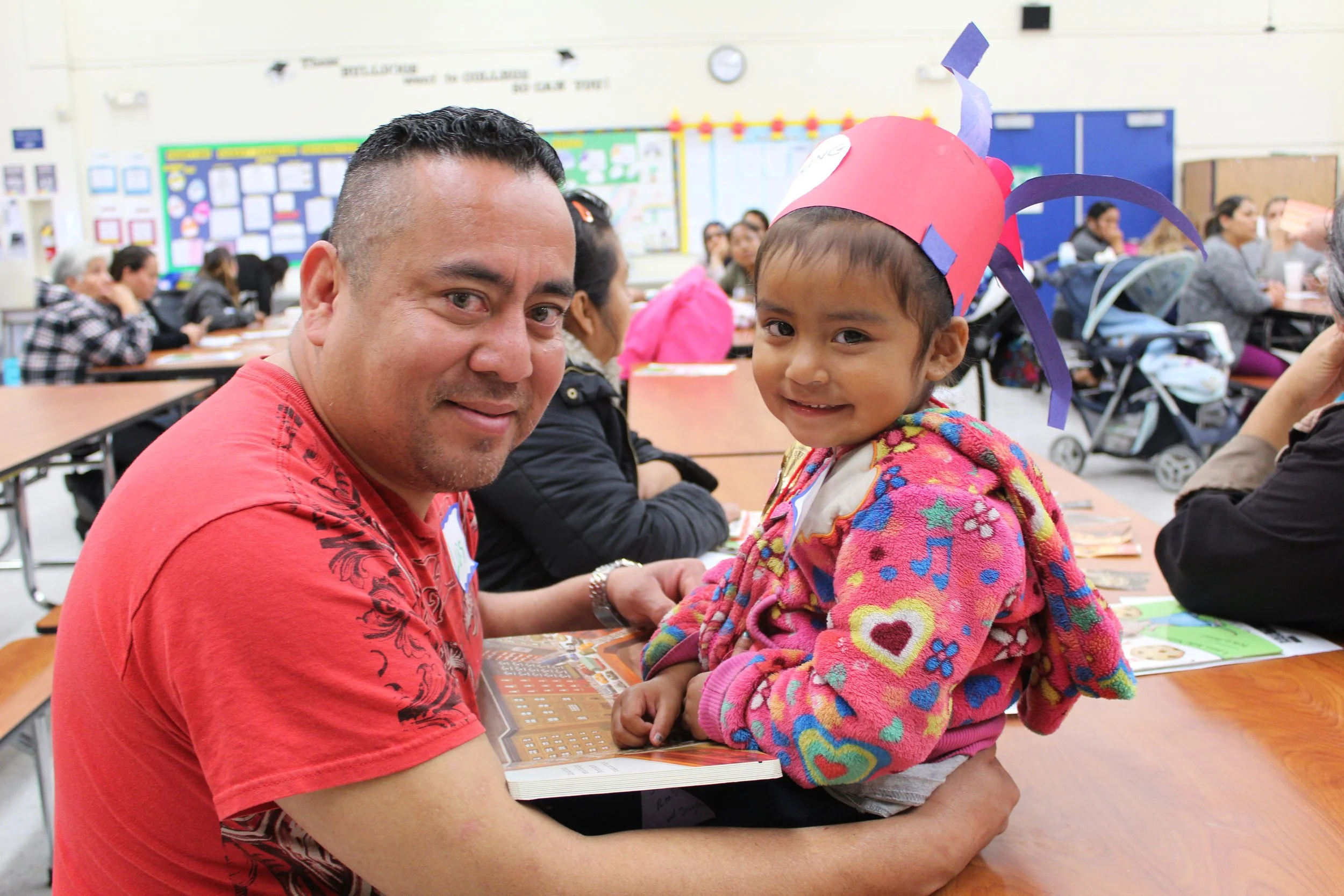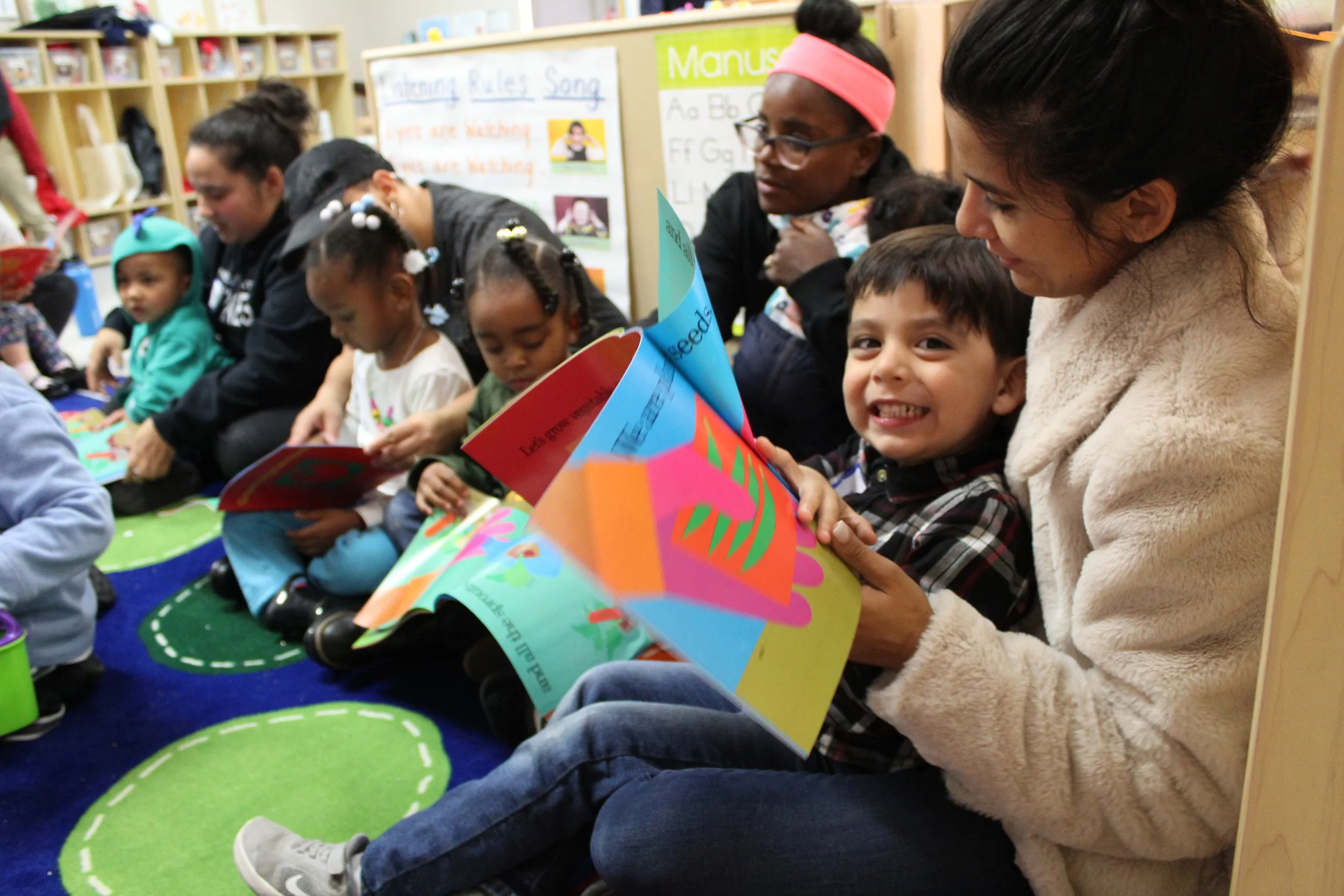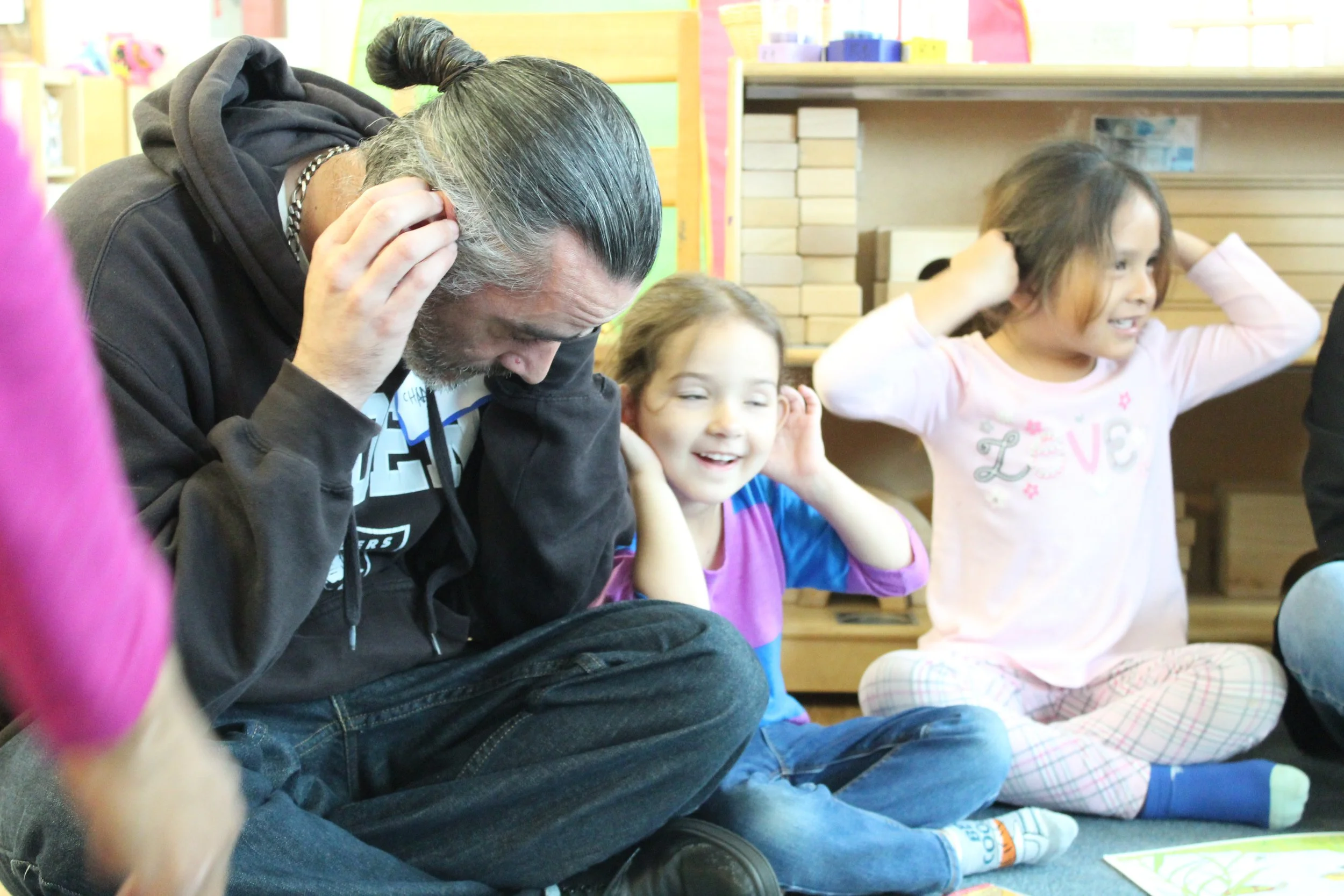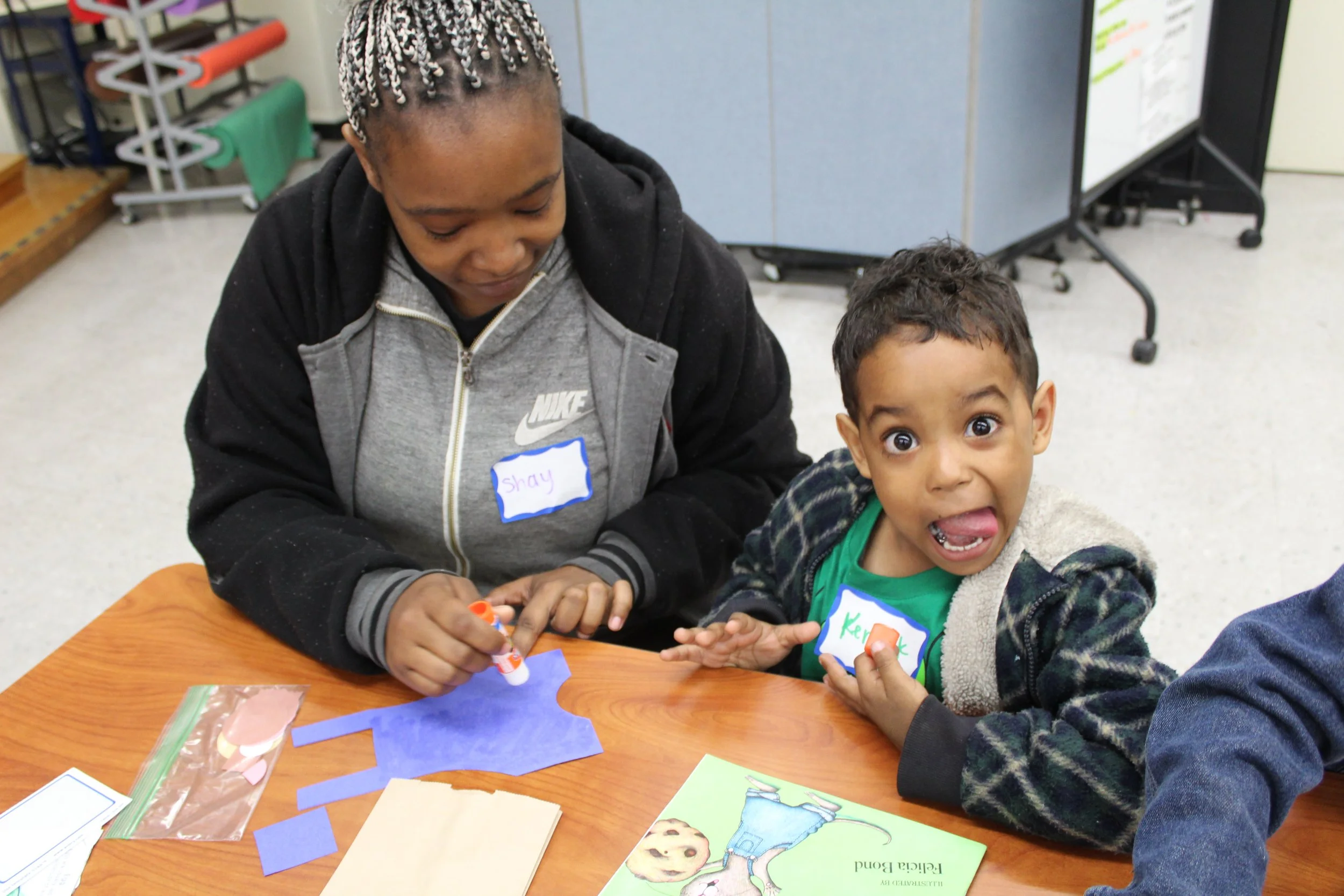Program Structure
Embedded in the Let’s Read session structure are behavior cues referred to as the “5 Rituals of Let’s Read.” These cues reinforce to children and families that reading is a special and purposeful time together.
Rituals help encode attention regulation, empathy, and self-soothing patterns. The predictability of the ritual itself becomes a neurological anchor for learning and emotional safety.
Five Rituals of Let’s Read:
Celebrate Ourselves
Prepare Our Bodies
“Parts of the Book” Song
Picture Walk
Hug Our Books
Repetition is key to learning and remembering. By including the 5 Rituals of Let’s Read in every session, we ensure that children and families develop the habits, behaviors, and attitudes necessary to become lifelong learners.
Every session includes the same core elements. Details about how to implement the 5 Rituals can be found in the guides for every session.
Part 1: Welcome and Introductions
Signing In
-
In person: “Welcome to Let’s Read! We are super excited to have you joining us. Please sign in, then find a seat next to your littles.“
Virtual: ”Welcome to Let’s Read! We are super excited to have you joining us. Please sign in by typing your little’s name in the chat.“
-
Action: Have a sign in sheet ready for all participants to sign in & distribute materials accordingly.
Each child receiving materials needs to sign in.
If siblings participate and receive their own materials, families must sign in twice or write in the notes how many children participated.
-
Attendance is important not only for assessing the positive impact we are having on the community but also for tracking the progress children make through their participation in our program
Purpose
-
“Every week, we do three fun things: celebrate, explore, and try something new! Let’s start by celebrating — give yourself two pats on the back for being here today!”
-
Lead with enthusiasm and exaggerated motions as you dictate your actions so that participants can mimic you.
Stand or sit up tall – Make sure your back is nice and straight.
Lift your right hand – Get it ready to pat your back.
Reach behind your shoulder – Gently place your hand on your own back, around the middle or upper part.
Give one gentle pat – Say, “Good job!” or “Yay me!” if you like.
Switch hands – Lift your left hand this time.
Pat your back again – One more gentle pat to celebrate yourself.
Smile and feel proud – You just celebrated yourself for being here and trying your best!
-
Praising families and showing that we’re proud of their participation helps everyone feel confident and happy. Repeating routines is also key to our program’s long-term impact — when children become used to doing something regularly, they are more likely to continue those positive habits after the program ends.
Power of Play
-
“Play is children’s work – they learn best when they do. Each week, everything we do connects back to our two major themes: The power of play & finding ways to reading more playful.”
-
Repeat this at every session to help adults see that when storytime is fun, children want to read — that’s why our playful reading method works so well.
-
When parents and caregivers understand the importance of making reading fun and learn the tools to do so, they inspire real change at home. Families develop healthy reading habits — not because they’re forced, but because they want to.
Part 2: Introducing the Book
Picture Walk
-
"Let’s peek inside our book today — (insert book title) — and see what surprises and adventures are hiding on the pages! Who’s ready to explore with me?"
"Let’s open (insert book title) and see if we can guess what’s going to happen! Can you spot any clues in the pictures?"
"Get ready! We’re about to jump into (insert book title) and see all the fun and surprises inside! Who’s excited to read with me?"
-
Open the Book Anywhere
Pick a page in the book — any page! Don’t worry about starting at the beginning.Look Closely at the Pictures
Take a moment to notice everything in the picture. What do you see? Are there animals, people, or interesting objects?Point Out Fun Things
Show things that catch your eye. For example:“Look at that lion! What is it doing?”
“See that tree? How is it different from the one outside?”
Ask Questions
Make guesses about the story using the pictures. Example questions:“Why do you think the monkey is hiding?”
“What might happen next?”
Connect to Real Life
Talk about things in the picture that remind you of real life:“That bird looks like the one in our backyard!”
“Have you ever seen a rainbow like that?”
Notice Patterns or Themes
Look for repeated ideas or interesting elements, like:Animals and their characteristics
Facts about nature or the world
Comparisons (big vs. small, fast vs. slow, etc.)
Get Excited to Learn!
Share what’s interesting or surprising about the picture and show curiosity:“I wonder what will happen next?”
“I can’t wait to read more!”
-
Sparking children’s excitement in reading and being part of the session is a great way to start! Asking questions and encouraging them to share their ideas makes them feel involved and eager to join in. When caregivers see how much fun their kids are having with books — something they might not have expected — they learn how powerful it can be. When we make storytime interactive, playful, and fun, families are inspired to use the same methods in their daily lives.
Introducing the Genre or Theme
-
ABC - Rhyming - Sequence/Pattern - Wordless - Fiction - Nonfiction
-
"Friends, today we’re going to read a special kind of book! This book is a (insert theme ) book. “
-
Knowing the theme at the beginning helps kids share their ideas and join the fun, while also helping caregivers see how the session supports learning and how they can keep exploring the theme at home.
The Importance of Different Genres
-
Build Early Letter Recognition
Seeing letters over and over helps children connect shapes to sounds, which is the first step toward reading.Strengthen Vocabulary
Every letter introduces new words, helping kids talk, think, and describe more clearly.Teach Order & Sequencing
The alphabet has a set order, so ABC books naturally build memory and pattern skills.Boost Phonemic Awareness
Hearing “A is for Apple” helps children match sounds to symbols — a key pre-reading skill.Make Learning Feel Playful
ABC books often include rhyming, rhythm, silly pictures, or themes, turning learning into fun instead of pressure.Encourage Participation & Confidence
Kids can shout out letters, repeat phrases, or guess the next word — making them active readers, not just listeners.Set the Foundation for Writing
Recognizing letters prepares children to eventually write them — ABC books make letters feel familiar before holding a pencil.
ABC books are not only fun and playful, but they are a great resource to help children learn and distinguish individual letter recognition, strengthen vocabulary, and boost phonemic awareness.
-
They train the brain to hear patterns in sound, which is a key skill for learning to read.
Rhymes make words easier to remember, helping build a strong vocabulary.
Hearing similar sounds together strengthens memory and prediction skills, helping children to guess what comes next.
Rhyming helps children break words into smaller sounds, which prepares them for spelling.
The rhythm and repetition keep kids engaged, making reading feel fun — not like work.
Singing or chanting rhyming lines builds confidence, encouraging kids to join in and use their voice.
Rhyming stories activate both sides of the brain — language + music — which boosts overall learning.
-
They teach children how to predict what comes next, building strong thinking and problem-solving skills.
Repeating phrases or actions helps with memory, making it easier for kids to retell or act out the story.
Understanding order (first, next, last) prepares children for real-life routines and school readiness.
Kids feel confident when they can “join in” because they know what’s coming, boosting participation and language use.
Sequence books help children understand cause and effect, an important part of critical thinking.
They encourage storytelling and retelling, which builds strong comprehension skills.
-
They boost imagination — with no words on the page, children create the story in their own minds.
They build language skills — even without text, toddlers describe what they see, which strengthens vocabulary and speaking.
They teach storytelling — kids learn how to explain what’s happening in order (beginning → middle → end).
They support comprehension — focusing on pictures helps toddlers understand emotions, actions, and cause-and-effect.
They grow confidence — even kids who can’t read yet can “tell” the story themselves!
They encourage bonding — caregivers and children naturally talk more during wordless books, making reading interactive, not passive.
-
A fiction book is a make-believe story!
They build imagination — fiction helps children picture new worlds, animals, and ideas that don’t exist in real life.
They teach emotions and empathy — when characters feel happy, scared, or sad, children learn to understand and name their own feelings.
They help with problem-solving — stories often include challenges or surprises that encourage children to think, “What would I do?”
They introduce storytelling structure — kids learn that stories have a beginning, middle, and end.
They make reading magical — funny or silly characters keep children engaged and excited to read more books!
-
They feed natural curiosity — Young children love asking “What’s that?” and nonfiction books give them real answers!
They build real-world knowledge —Exploring topics like animals, vehicles, weather, and food help children understand the world around them.
They grow vocabulary — Kids learn new words like scales, engines, planets, or habitats just by looking at pictures and naming things.
They encourage questioning and exploring — “Why do whales swim?” → “Let’s find out!” Nonfiction turns reading into discovery time.
They boost memory and thinking skills — Learning facts helps children sort and organize information in their brain.
They build confidence — Even young kids feel proud when they can teach YOU something they learned from a book!
They balance imagination with truth — Fiction helps kids dream, and nonfiction helps them understand the wonder of the real world around them.
-
Take time to explain to parents and caregivers why we read each type of book. When they understand the purpose, they grow confidence using these books in their daily lives to support and enrich learning.
-
Why Parents and Caregivers Should Know About Different Book Types
Empowers them to support learning at home — When caregivers understand the purpose of each book type, they can choose books and activities that reinforce skills.
Makes reading intentional, not just routine — Caregivers see that every book has a role in developing their child’s literacy, from letters and sounds to imagination and critical thinking.
Encourages confidence — Knowing why they are reading certain books helps caregivers feel confident engaging with their child, asking questions, and joining in the story.
Strengthens bonding — Interactive reading becomes a meaningful experience between a caring adult and a child, which improves communication and connection.
Promotes consistent learning beyond the program — Caregivers can replicate the strategies and book choices outside of program sessions, turning everyday reading into an intentional learning experience.
Part 3: Preparing Our Bodies to Read
-
Boosts Focus and Attention: Using your eyes and ears helps young children notice every picture, word, and sound in the story.
Helps Refocus Attention: When children get rowdy or distracted, these tools guide them back to the book and story.
Encourages Active Participation: Children become part of the story instead of just sitting and listening.
Supports Early Literacy Skills: Looking, listening, and speaking develops observation, comprehension, vocabulary, and phonemic awareness.
Makes Reading Predictable and Fun: Using body-part routines gives toddlers clear cues for how to engage, making story time enjoyable and less frustrating.
Builds Confidence: Children feel proud and capable when they know how to use their “reading tools” during every story.
-
Use these tools to help refocus on the story and stay engaged during reading time.
“Let’s turn down our voice box and switch on our listening ears so we can hear the rest of the story!”
“Let’s use our observing eyes to find and count all the bugs in the book together!”
Highlight the illustrator’s amazing skills and encourage children to use drawing to share their own ideas and stories.
Observing Eyes
-
Make Your Binoculars
Take both hands and make big circles with your thumbs and fingers, like two round windows.
Put your hands up in front of your eyes — you’ve got your very own binoculars!
-
Look Closely
Peek through your hand circles at the pages of your book.
Try to find every picture, word, and tiny detail.
Spot the Fun Things
Can you see animals, colors, shapes, or funny faces?
Move your eyes around the page and check out everything you can see.
Take Your Time
Don’t rush! Super detectives with binoculars look slowly and carefully.
Share What You See
Tell a friend, a parent, or your reading buddy what you notice.
You can even point with your finger while you describe it!
Keep Practicing
Every page is a new adventure. The more you use your binoculars, the more details you’ll discover!
Listening Ears
-
Hold both hands up in front of you — fingers curved like you’re making the letter C.
Now slowly move those C’s up to your ears, one on each side… and stick them on — boop! Now you have your listening ears on.
Let’s adjust the volume and make sure they are working. - Take the C’s formed by your hands and twist them gently like you’re turning a little knob — “twist-twist-twist!”
While we test our listening ears, facilitators can make their voice go quiet and loud — just like turning the volume up and down — so we can hear the difference.
-
Using our listening ears helps children refocus on the reader and stay engaged, even if they start to get a little distracted.
Turning on our listening ears helps us notice clues and important parts in the book.
We turn on our listening ears so we can hear all the fun sounds in the story — like BOOM! SPLASH! TIP-TAP!
Listening ears help us hear our friends when they share their ideas — every voice is special.
Good listeners make the story even more fun, because we can hear, imagine, and explore together!
Voice Box
-
Hold up one hand and touch your thumb and finger together to make a tiny O — this is your finger leveler!
Put your finger leveler in front of your throat — this controls your voice box!
Move your finger leveler UP — make your voice BIG and LOUD like a giant!
Move your finger leveler DOWN — make your voice tiny and SOFT like a little mouse!
Keep tuning it all the way down… until we’re completely SILENT!
Let’s make it a fun game — get LOUD, then go completely SILENT, following the up-and-down motion of your voice box leveler!
This helps everyone practice controlling their voices during storytime.
-
Think of your voice box as a storytime helper! It teaches children how to use their voices wisely and brings attention back to the exciting parts of the book.
It helps us change the volume of the room — When everyone turns their voice boxes down low, it gets quiet and cozy for listening.
It helps us talk when it’s our turn — We turn our voice box ON when we want to share an idea or make a sound from the story!
It lets us make silly story sounds — ROAR! SPLASH! TWEET! BOOM! make the story more fun!
It helps us sound like the characters — We can try soft voices, loud voices, or even squeaky voices!
It reminds our bodies to take turns — Voice box off when someone else is reading, voice box on when it’s our turn to play along!
It makes us great storytellers — Using our voice box helps us practice being brave speakers and good listeners!
Part 4: “Parts of the Book” Song
“Parts of Book” Song Lyrics
The title’s on the front (x2)
Hi-ho biblio, the title’s on the front
The author writes the words (x2)
Hi-ho biblio, the author writes the words
The illustrator draws (x2)
Hi-ho biblio, the illustrator draws
The spine binds the book (x2)
Hi-ho biblio, the spine binds the book
Now it’s time to read (x2)
Hi-ho biblio, now it’s time to read!
-
Use the melody of ‘The Farmer in the Dell’ to sing the “Parts of the Book.”
If singing isn’t your strength, that’s okay! Just make sure you try and have fun — that is what really matters.
After a few sessions, families will be able to join in and sing along with you.
Optional:
In-person: Give families the song lyrics so they can practice and sing along with you.
Virtual: Share the lyrics in the chat so families can read and sing along with you.
-
Teaching children the elements of a book is often overlooked, but it helps give them early knowledge they will use in school.
Starting with a song signals that storytime is about to begin.
It helps kids pause what’s happening around them and get ready for storytime, so they can enjoy a fun reading adventure.
Recognizing the song helps children get excited and ready, just like with the clean-up song.
Singing in front of the group takes courage, but the joy it brings kids is worth it! Adults see how storytime comes alive, helping families build happy reading and learning habits at home.
Click the button below to see a Let’s Read session in action, including rituals and a fun storytime!
Best Practices for Facilitators
Power Phrases
“I wonder...
I notice...
Tell me more....”
-
Power Phrases are prompts that spark conversation throughout the story. They’re designed not just for reading the book, but to make story time interactive and encourage meaningful discussion.
Don’t limit these phrases to storytime — they can be used anywhere and everywhere, and are excellent for supporting your child’s development.
-
When you use a Power Phrase to explore a concept, it removes the pressure from children and families that there has to be a correct answer. It opens up all possible answers, connections, experiences, and ideas. It allows children the freedom – and imagination – to make sense of anything!
-
As you are reading, pause occasionally and zoom in to a particular moment in the story – a picture, a character, a word. Say: “Tell me more about this” or “I wonder what will happen next” and invite the children to use their imaginations (and their voices!).
During a Let’s Read session, our facilitators use Power Phrases themselves and also help caregivers practice using Power Phrases with their own children.
In addition to storytime, Power Phrases can be used when playing games, when on walks or drives, while eating a meal, or any other wide variety of settings.`
Cooperative Learning Strategies
Research shows that cooperative learning has been effective for all types of students, including academically gifted, mainstream students, and English language learners (ELLs). Feel free to engage students by using the suggested strategies below!
-
Put your finger on your nose if you hear a set of rhyming words.
-
Put your hand up if you think…
-
Thumbs up if you think…
-
Say “me too” if you agree and point to yourself.
-
This activity is a great way for children to be able to pause and process what they have just learned.
Ask the group a question that they must first consider by themselves then give them the opportunity to discuss it with their neighbor. Once they’ve discussed the question, children can share their answers with the group.
Giving children this time empowers them to deepen their engagement in the book. -
End of book reading summaries are a great way to engage your children and help them connect the dots on their own.
As a group, have the children complete an A-Z Topic Summary, saying a word or a sentence related to the reading for each letter of the alphabet. For example, if we learned about a bear, one child could say a describing word such as “amazing,” the second child might say “brave,” etc. -
Quick draw is especially engaging for visual learners or children that aren’t quite writing yet. After reading, have the children use a white board to draw a picture about what they’ve just learned.
For example, after reading part of the story: Jack and the Bean Stalk, have your students draw what has happened in the story up to that point. Then a student may draw a picture of a boy planting seeds with a bean stalk growing in the background.
-
Studies show that the proper ratio of direct instruction to reflection time for students is ten to two. That means that for every ten minutes of instruction, we need to provide children with two minutes for reflection.
Quick writes provide children with that much needed reflection time! Ask a question about a topic or concept that has been covered in the book. Using a whiteboard, children can write an answer and then share it with a partner and/or the whole group.
-
Encourage the class to join in with repetitive phrases/words in the book.
-
Encourage children to use actions to go along with characters/words in the book. This can help if you have a squirmy class, either interspersed throughout the reading or as an active break to get the children up and moving.
-
By prompting children to stand up or sit down in response to different questions/statements, facilitators help learners differentiate between any two categories while moving their bodies.
For the Spanish version of this webpage, please click this “ Spanish Rituals” button.

